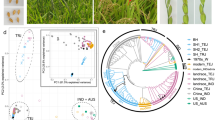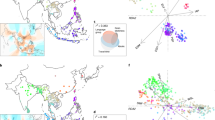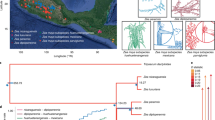Abstract
The origin of maize (Zea mays mays) in the US Southwest remains contentious, with conflicting archaeological data supporting either coastal1–4 or highland5,6 routes of diffusion of maize into the United States. Furthermore, the genetics of adaptation to the new environmental and cultural context of the Southwest is largely uncharacterized7. To address these issues, we compared nuclear DNA from 32 archaeological maize samples spanning 6,000 years of evolution to modern landraces. We found that the initial diffusion of maize into the Southwest about 4,000 years ago is likely to have occurred along a highland route, followed by gene flow from a lowland coastal maize beginning at least 2,000 years ago. Our population genetic analysis also enabled us to differentiate selection during domestication for adaptation to the climatic and cultural environment of the Southwest, identifying adaptation loci relevant to drought tolerance and sugar content.
This is a preview of subscription content, access via your institution
Access options
Subscribe to this journal
Receive 12 digital issues and online access to articles
$119.00 per year
only $9.92 per issue
Buy this article
- Purchase on Springer Link
- Instant access to full article PDF
Prices may be subject to local taxes which are calculated during checkout



Similar content being viewed by others
References
Gregory, D. Excavations in the Santa Cruz River Floodplain (Center for Desert Archaeology, 1999).
Huckell, L. in Histories of Maize (eds Staller, J., Tykot, R. & Benz, B. F.) 97–106 (Elsevier, 2006).
Cutler, H. in Mogollon Cultural Continuity and Change: The Stratigraphic Analysis of Tularosa and Cordova Caves (eds Martin, P., Rinaldo, J., Bluhm, E., Cutler, H. & Grange, R.) 461–479 (Chicago Natural History Museum, 1952).
González, J. in Corn and Culture in the Prehistoric New World (eds Johannessen, S. & Hastorf, C.) 135–157 (Westview, 1994).
Haury, E. in Courses Toward Urban Life (eds Braidwood, R. & Willey, G.) 106–131 (Aldine, 1962).
Ford, R. in Prehistoric Food Production in North America. Museum of Anthropology Anthropological Papers (ed. Ford, R.) 341–364 (University of Michigan, 1985).
Merrill, W. L. et al. The diffusion of maize to the southwestern United States and its impact. Proc. Natl Acad. Sci. USA 106, 21019–21026 (2009).
Gross, B. L. & Zhao, Z. Archaeological and genetic insights into the origins of domesticated rice. Proc. Natl Acad. Sci. USA 111, 6190–6197 (2014).
Van Heerwaarden, J. et al. Genetic signals of origin, spread, and introgression in a large sample of maize landraces. Proc. Natl Acad. Sci. USA 108, 1088–1092 (2011).
Piperno, D. R., Ranere, A. J., Holst, I., Iriarte, J. & Dickau, R. Starch grain and phytolith evidence for early ninth millennium B.P. maize from the Central Balsas River Valley, Mexico. Proc. Natl Acad. Sci. USA 106, 5019–5024 (2009).
Matsuoka, Y. et al. A single domestication for maize shown by multilocus microsatellite genotyping. Proc. Natl Acad. Sci. USA 99, 6080–6084 (2002).
Avila-Arcos, M. C. et al. Application and comparison of large-scale solution-based DNA capture-enrichment methods on ancient DNA. Sci. Rep. 1, 74 (2011).
Chia, J., Song, C., Bradbury, P. & Costich, D. Maize HapMap2 identifies extant variation from a genome in flux. Nature Genet. 44, 803–807 (2012).
Patterson, N. J. et al. Ancient admixture in human history. Genetics 192, 1065–1093 (2012).
Fang, Z. et al. Megabase-scale inversion polymorphism in the wild ancestor of maize. Genetics 191, 883–894 (2012).
Pickrell, J. K. & Pritchard, J. K. Inference of population splits and mixtures from genome-wide allele frequency data. PLoS Genet. 8, e1002967 (2012).
Hufford, M. B. et al. The genomic signature of crop-wild introgression in maize. PLoS Genet. 9, e1003477 (2013).
Li, Y. et al. Resequencing of 200 human exomes identifies an excess of low-frequency non-synonymous coding variants. Nature Genet. 42, 969–972 (2010).
Hufford, M. B. et al. Comparative population genomics of maize domestication and improvement. Nature Genet. 44, 808–811 (2012).
Weber, A. L. et al. The genetic architecture of complex traits in teosinte (Zea mays ssp. parviglumis): new evidence from association mapping. Genetics 180, 1221–1232 (2008).
Gallavotti, A. et al. The role of barren stalk1 in the architecture of maize. Nature 432, 630–635 (2004).
Weber, A. et al. Major regulatory genes in maize contribute to standing variation in teosinte (Zea mays ssp. parviglumis). Genetics 177, 2349–2359 (2007).
Wang, H. et al. The origin of the naked grains of maize. Nature 436, 714–719 (2005).
Liu, S. et al. Genome-wide analysis of ZmDREB genes and their association with natural variation in drought tolerance at seedling stage of Zea mays L. PLoS Genet. 9, e1003790 (2013).
Wilson, L. M. et al. Dissection of maize kernel composition and starch production by candidate gene association. Plant Cell 16, 2719–2733 (2004).
Schultz, J. A. & Juvik, J. A. Current models for starch synthesis and the sugary enhancer1 (se1) mutation in Zea mays. Plant Physiol. Biochem. 42, 457–464 (2004).
Brien, M. J. O. et al. Drought survival of tropical tree seedlings enhanced by non-structural carbohydrate levels. Nature Clim. Change 4, 710–714 (2014).
Dinges, J. R., Colleoni, C., Myers, A. M. & James, M. G. Molecular structure of three mutations at the maize sugary1 locus and their allele-specific phenotypic effects. PLANT Physiol. 125, 1406–1418 (2001).
Zeder, M. A., Emshwiller, E., Smith, B. D. & Bradley, D. G. Documenting domestication: the intersection of genetics and archaeology. Trends Genet. 22, 139–155 (2006).
Larson, G. & Burger, J. A population genetics view of animal domestication. Trends Genet. 29, 197–205 (2013).
Yamasaki, M. et al. A large-scale screen for artificial selection in maize identifies candidate agronomic loci for domestication and crop improvement. Plant Cell 17, 2859–2872 (2005).
Whitt, S. R., Wilson, L. M., Tenaillon, M. I., Gaut, B. S. & Buckler, E. S. Genetic diversity and selection in the maize starch pathway. Proc. Natl Acad. Sci. USA 99, 12959–12962 (2002).
Cooper, A. & Poinar, H. N. Ancient DNA: do it right or not at all. Science 289, 530–531 (2000).
Gilbert, M. T. P. et al. Ancient mitochondrial DNA from hair. Curr. Biol. 14, R463–R464 (2004).
Cappellini, E. et al. A multidisciplinary study of archaeological grape seeds. Naturwissenschaften 97, 205–217 (2010).
Wales, N., Andersen, K., Cappellini, E., Avila-Arcos, M. C. & Gilbert, M. T. P. Optimization of DNA recovery and amplification from non-carbonized archaeobotanical remains. PLoS ONE 9, e86827 (2014).
Jónsson, H., Ginolhac, A., Schubert, M., Johnson, P. L. F. & Orlando, L. mapDamage2.0: fast approximate Bayesian estimates of ancient DNA damage parameters. Bioinformatics 29, 1682–1684 (2013).
Gnirke, A. et al. Solution hybrid selection with ultra-long oligonucleotides for massively parallel targeted sequencing. Nature Biotechnol. 27, 182–189 (2009).
Acknowledgements
The authors acknowledge the following grants: Marie Curie Actions IEF 272927 and COFUND DFF-1325-00136, Danish National Research Foundation DNRF94, Danish Council for Independent Research 10-081390 and 1325-00136, Lundbeck Foundation grant R52-A5062, Vand Fondecyt Grant 1130261, a grant from the UC Davis Genome Center for the highland maize sequence and NSF IOS-1238014. R.F. is supported by a Young Investigator grant (VKR023446) from Villum Fonden. P.S. was funded by the Wenner-Gren foundation. The authors thank Ângela Ribeiro, Shohei Takuno and Philip Johnson for comments and discussion and staff at the Danish National High-Throughput DNA Sequencing for technical support.
Author information
Authors and Affiliations
Contributions
M.T.P.G., B.D.S. and R.R.F. conceived and headed the project. M.T.P.G., N.W. and E.C. designed the experimental research project setup. R.R.F. designed the bioinformatics and population genetics setup with input from M.T.P.G., A.A. and J.R.I. Both B.D.S. and B.A. provided ancient samples and associated context information. M.B.H. and J.R.I. provided sequence data for the highland Palomero de Jalisco landrace. B.D.S. provided the archaeological background and performed the radiocarbon dating. N.W., E.C. and C.C. performed the ancient DNA extractions, library construction and capture with input from M.T.P.G. Both M.C.A. and J.A.S. provided bioinformatics support for the optimization of the capture-related laboratory work. J.A.S. annotated the silent and non-synonymous sites. TSK designed the tool to filter transitions in bam files. R.R.F. chose the capture targets, performed the quality filtering and mapping of the ancient datasets, and prepared the maize HapMap2 data and the modern genome data for all downstream analyses. R.R.F. performed the error determination, neutrality tests, NGSadmix, TreeMix, phylogenetic and demographic inference analyses with input from A.A. and J.R.I. D-statistics analysis was performed by P.S. with input from M.J. Both R.R.F. and M.F. performed the PBS-based selection analyses with input from R.N. Both D.E.H. and M.B.H. performed the STRUCTURE analysis. F.G.V. performed the inbreeding analysis. R.R.F., B.D.S., M.B.H., J.R.I. and M.T.P.G. wrote the manuscript with critical input from all authors.
Corresponding authors
Ethics declarations
Competing interests
The authors declare no competing financial interests.
Supplementary information
Rights and permissions
About this article
Cite this article
da Fonseca, R., Smith, B., Wales, N. et al. The origin and evolution of maize in the Southwestern United States. Nature Plants 1, 14003 (2015). https://doi.org/10.1038/nplants.2014.3
Received:
Accepted:
Published:
DOI: https://doi.org/10.1038/nplants.2014.3
This article is cited by
-
A ton of Plants
Nature Plants (2023)
-
Genetic continuity and change among the Indigenous peoples of California
Nature (2023)
-
Nobel adjacency
Nature Plants (2022)
-
Domestication, crop breeding, and genetic modification are fundamentally different processes: implications for seed sovereignty and agrobiodiversity
Agriculture and Human Values (2022)
-
Open transformation
Nature Plants (2021)



